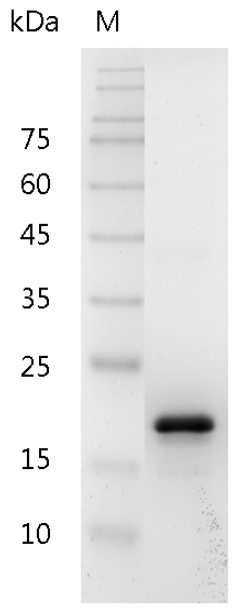| Background |
BAFF also known as BLYS, TALL-1 and TNFSF13B, which belongs to tumor necrosis factor family. BAFF is a 31.2 kDa type II transmembrane protein containing 285 residues that predominantly produced by myeloid cells, furthermore mouse BAFF shares 72% sequence identity with human BAFF. BAFF has been demonstrated to activate the survival of B cells and the B cell response by binding to BAFFR/BR3. Additionally, BAFF also takes part in regulating B and T cell function via forming two ligands-two receptors pathway through sharing TNFRSF13B/TACI and TNFRSF17/BCMA receptors with APRIL. |
| Synonyms |
B-cell activating factor, tumor necrosis factor (ligand) superfamily, member 13b,Tnfsf13b, BAF, BL, BLyS, D8Ertd387, D8Ertd387e, TAL, TALL-1, TALL1, THANK, TNFSF20, Tnlg7a, zTNF, zTNF4 |
| Uniprot ID |
Q9WU72 |
| Molecular Weight |
The protein has a calculated MW of 21.56 kDa.
The protein migrates as 17-25 kDa under reducing condition (SDS-PAGE analysis). |
| Expression System |
Escherichia coli |
| Purity |
>98% as determined by SDS-PAGE. |
| Activity |
Measure by its ability to induce proliferation in mouse B cells.
The ED₅₀ for this effect is <0.5 ng/mL.
The specific activity of recombinant mouse BAFF is > 2 x 10⁶ IU/mg. |
| Endotoxin Level |
<0.1 EU per 1 μg of the protein by the LAL method. |
| Protein Sequence |
MAFQGPEETEQDVDLSAPPAPCLPGCRHSQHDDNGMNLRNIIQDCLQLIADSDTPTIRKGTYTFVPWLLSFKRGNALEEKENKIVVRQTGYFFIYSQVLYTDPIFAMGHVIQRKKVHVFGDELSLVTLFRCIQNMPKTLPNNSCYSAGIARLEEGDEIQLAIPRENAQISRNGDDTFFGALKLL with polyhistidine tag at the C-terminus. |
| Protein Tag |
His Tag (C-term) |
| Form |
The protein was lyophilized from a 0.2 µm filtered solution containing 1X PBS, pH 7.4. If you have any concerns or special requirements, please confirm with us. |
| Application |
Cell Culture |

 No references are available
No references are available
 Follow Us
Follow Us